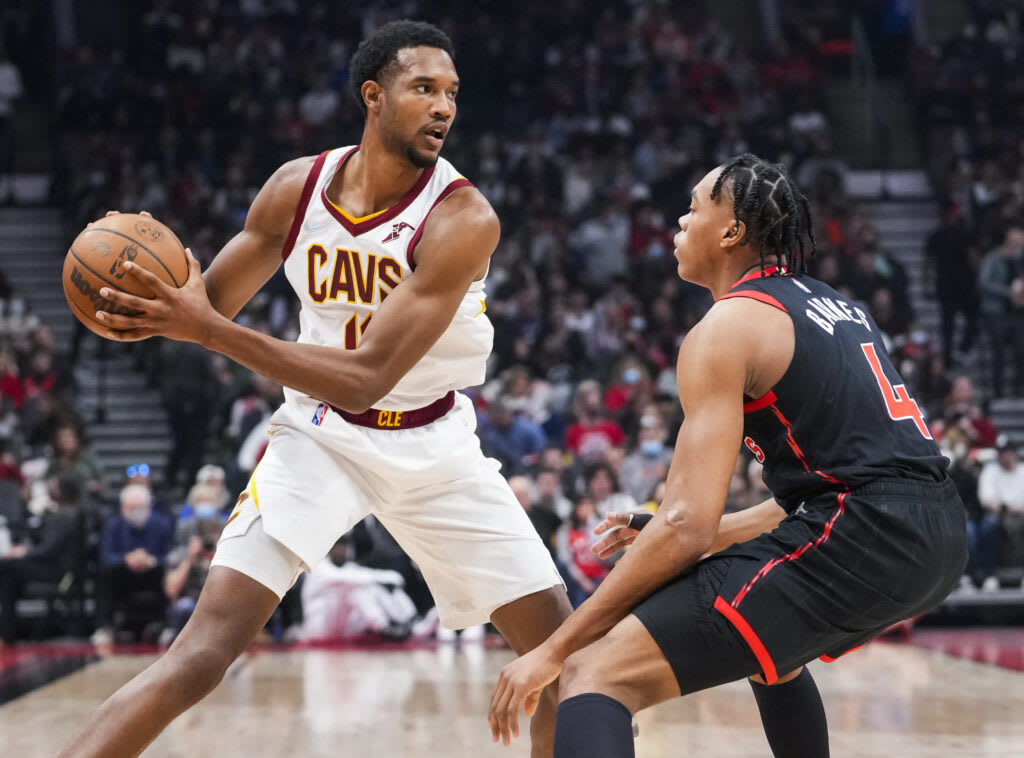Rookies aren’t supposed to be positive NBA players right out of the gate. It is supposed to take a long time to adapt one’s game to the physicality, speed, and tactical requirements of the NBA. Even future Hall of Famers can struggle in their first days in the league; Kobe Bryant, for example, averaged only 4.9 points per game in his first 10.
Yet this season’s rookie class seems to have more than its fair share of rookie contributors. Of 57 rookies who’ve seen time in NBA games, 10 have been consistent starters. And two have distinguished themselves far beyond the rest of the pack: Scottie Barnes and Evan Mobley are both already extremely productive players, and for now they seem to have pulled into the lead for the Rookie of the Year Award. In fact, since the year 2000, when compared to all rookies’ first 10 games, Barnes and Mobley have both put together top-25 stretches.
Ranking the 10 highest average game scores from rookies’ first 10 games since 2000
| Rank | Player | Team | Year | Game Score |
|---|---|---|---|---|
| 1 | Brandon Jennings | MIL | 2009 | 17.3 |
| 2 | Zion Williamson | NOP | 2020 | 17 |
| 3 | Ben Simmons | PHI | 2017 | 16.5 |
| 4 | John Wall | WAS | 2010 | 15.3 |
| 5 | Deandre Ayton | PHO | 2018 | 15.1 |
| 6 | Derrick Rose | CHI | 2008 | 14.8 |
| 7 | Chris Paul | NOK | 2005 | 14.6 |
| 8 | Michael Carter-Williams | PHI | 2012 | 14 |
| 9 | Scottie Barnes | TOR | 2021 | 13.9 |
| 10 | Damian Lillard | POR | 2012 | 13.9 |
| 11 | Tyrese Haliburton | SAC | 2020 | 13.4 |
| 12 | Luka Dončić | DAL | 2018 | 13.4 |
| 13 | Trae Young | ATL | 2018 | 13.1 |
| 14 | O.J. Mayo | MEM | 2008 | 12.8 |
| 15 | Anthony Davis | NOH | 2012 | 12.7 |
| 16 | Karl-Anthony Towns | MIN | 2015 | 12.5 |
| 17 | LeBron James | CLE | 2003 | 12.5 |
| 18 | Blake Griffin | LAC | 2010 | 12.3 |
| 19 | LaMelo Ball | CHO | 2020 | 12.2 |
| 20 | Joel Embiid | PHI | 2016 | 12.2 |
| 21 | Ja Morant | MEM | 2019 | 12.1 |
| 22 | Kyle Kuzma | LAL | 2017 | 11.9 |
| 23 | Evan Mobley | CLE | 2021 | 11.8 |
| 24 | Eric Paschall | GSW | 2019 | 11.8 |
| 25 | Lauri Markkanen | CHI | 2017 | 11.7 |
Success and the same draft year aren’t all that the two players share. In fact, there are a variety of components to their games that could tie the two together for a long time to come.
Defensive Versatility
It’s hard to be successful in today’s NBA if one’s skills only fit in one type of system. Fortunately for the Toronto Raptors and Cleveland Cavaliers, their star rookies should be able to thrive in almost any situation.
Barnes entered the league as a point guard playing off the bench for Florida State, and he’s currently starting at center for the Raptors. He’s six foot nine with a seven-foot-three wingspan, which allows him to bottle up most players on the ball while also protecting the rim. In fact, Bball Index ranks him as the 10th most versatile defender in the league so far this season, spending at least 10 percent of his time guarding every position on the floor.
There’s no limitation to the players Toronto asks him to guard; the list of 10 players Barnes has spent the most minutes guarding, includes initiating guards like Luka Doncic and James Harden, scoring wings like Jayson Tatum, and bruising bigs like Robert Williams III and Mobley himself. Barnes is the only player in the league to have spent at least 20 percent of his time guarding point guards and 20 percent guarding centers.
Despite the unique challenges, Barnes has performed admirably. The defense is no better or worse with him on the floor — which is rare and impressive for a rookie, especially one with such responsibility on an already elite defensive squad. The team fouls less and rebounds better when he’s playing versus when he’s sitting.
He’s already quick at recognizing help responsibilities, and he has the athleticism and timing to erase sure things.
Meanwhile in Cleveland, Mobley is contesting the second-most shots in the league while limiting opponents’ field goal percentages around the rim by eight percent lower than expected. When Mobley sits, the Cavaliers’ defense falls off a cliff. His average defensive win shares are the highest for a rookie since 1997-98, when Tim Duncan came out of Wake Forest and finished fifth in MVP voting.
Mobley isn’t just a big who’s rooted to the paint. He can switch onto anyone, include some of the best guards in the league, and not just hold his own but annihilate the play.
Of course, when Cleveland wants Mobley to act like a traditional big, he can play drop defense and choke off the rim. He can block shots with the best of them. Put all his skills together, and you can build a defense around Mobley. That’s not a prediction for the future — he’s already one of the top defensive players in the league, ranked by FiveThirtyEight’s RAPTOR as tied as the third-best defender thus far through the season.
Teams playing big
Because of both Barnes and Mobley’s defensive versatility, their respective teams are able to play unique lineups. Well, not quite unique — in fact, the two teams’ defensive approaches are distinct from every team except for one other.
In an NBA that’s spent some of the last few seasons downsizing in the mold of the Golden State Warriors, both Toronto and Cleveland are heading in the other direction.
Since Pascal Siakam returned to the lineup for Toronto, the Raptors have started all of Siakam, Barnes, and OG Anunoby together — three forwards with wingspans over seven feet. Toronto’s offense has been hit and miss, but it leads the NBA in offensive rebounding rate and creates transition chances by forcing the second-highest opponent turnover rate. That combination represents a reinvention of their approach to the game, and Barnes is at the heart of unlocking the philosophy.
Barnes does an enormous amount to make Toronto’s offense work with so many forwards on the floor together. He is a great passer and offensive rebounder for Toronto, combining his abilities to play point guard and center. He takes several shots in transition each game, cutting down on any of Toronto’s spacing issues. He’s an elite cutter, able to simulate space not with shooting but with off-ball movement. He may not be a three-point shooter yet, but he takes half of his shots from the midrange, where he’s surprisingly accurate.
The Raptors play big not to thrive on the offensive end, but to be one of the best defensive teams in the league. The offense scrapes by. Barnes is key not only to the defense being so ferocious, but also to the offense’s ability to survive.

If the Raptors are big, then the Cavaliers are elephantine, starting three seven-footers in Mobley, Jarrett Allen, and Lauri Markkanen when healthy. The Cavaliers do so because they prioritize the rim above all else. They rank in the top five in frequency of at-rim attempts in the league for the second year in a row, but this year they’re shooting 67 percent at the rim, the team’s best mark since LeBron James was a Cav. On the other end, they’re holding opponents to 59 percent at the rim, third lowest in the league. For these Cavs, basketball is simplified to a game of winning the contest in the paint.
Mobley is the key to making it work. His on/off differential for Cleveland’s at-rim frequency of attempts is +6.0 percent, and his on/off differential for opponents’ at-rim accuracy is -8.6 percent. Both are team highs and in the 90th-plus percentile league-wide.
Mobley may be shooting a ridiculous 73 percent at the rim, but he doesn’t just unlock Cleveland’s rim-based strategy because of his dominance in the paint. He’s versatile, able to open the floor and leave the paint vacant for his fellow behemoths. He’s currently making 30.8 percent of almost two triples per game, which may seem modest but is actually the 12th-most threes ever attempted per game by a seven-foot rookie. His ability to stretch the floor is one reason why Allen leads the league in dunks. Mobley, no slouch himself, is tied for fourth.
Furthermore, Mobley ends almost three pick and roll possessions per game as the screener, but he’s just as capable of running them as the handler. He’s more than comfortable throwing lobs or entry passes to his screener, but he’s also able to make advanced cross-court reads that would be impressive plays for veteran guards.
There’s no downside to playing big when Mobley can defend the perimeter like a guard, shoot like a guard, and even run pick and rolls like a guard.
Thus both Toronto and Cleveland play uniquely big lineups, and both are unlocked by their versatile rookies.
What it means going forward
Mobley and Barnes are connected in many ways. Both were drafted the same year and are in the midst of historic rookie seasons. Both are long and versatile and already catalysts for their respective teams’ unique plans. And they’ve already faced one another. Both players spent time guarding one another, and the game was an instant classic; the Cavaliers won by a single point as Barnes missed a tip-in at the buzzer to win.
They ought to remain linked going forward. Mobley and Barnes, the league, and fans everywhere can only hope that matchups between the two going forward will be so entertaining. For now, the two are competing for the Rookie of the Year Award. Soon, they should be competing for All-Star berths. And if both develop into the do-all colossus that they appear to be, Mobley and Barnes may well be set up for epic playoff clashes for many years to come, with only the sky and each other as their respective limitations.

